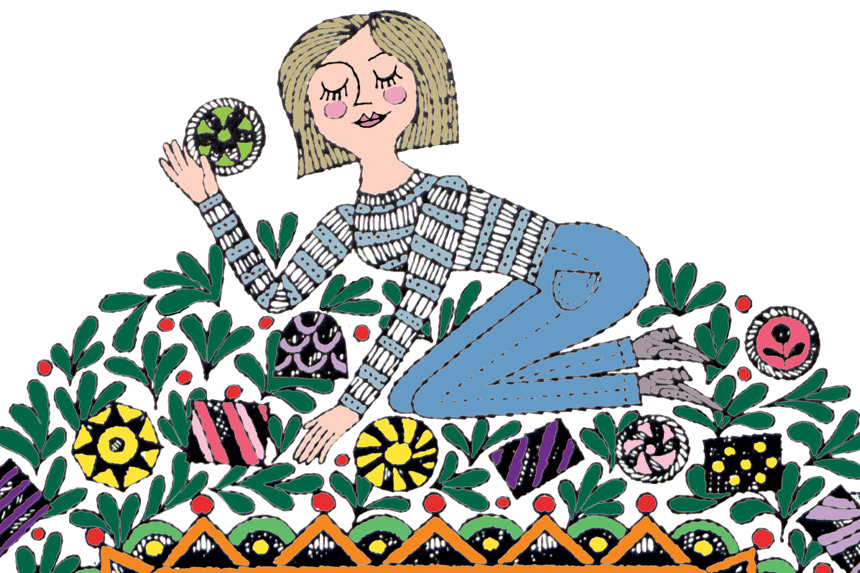This essay was originally published in The Saturday Evening Post on December 3, 1966 and also appears in our November/December 2018 issue.
You will perhaps have difficulty understanding why I conceived the idea of making 20 hard-candy topiary trees and 20 figgy puddings in the first place. The heart of it is that although I am frail, lazy, and unsuited to doing anything except what I am paid to do, which is sit by myself and type with one finger, I like to imagine myself a “can-do” kind of woman, capable of patching the corral fence, pickling enough peaches to feed the hands all winter, and then winning a trip to Minneapolis in the Pillsbury Bake-Off. In fact, the day I stop believing that if put to it I could win the Pillsbury Bake-Off will signal the death of something.
It was late in September, about the time certain canny elves began strategically spotting their Make It Yourself for Christmas books near supermarket checkout counters, when I sensed the old familiar discontent. I would stand there in the Westward Ho market, waiting to check out my frozen chicken tetrazzini and leafing through the books, and I would see how far I had drifted from the real pleasures. I did not “do” things. I did not sew spangles on potholders for my friends. I did not make branches of marzipan mistletoe for my hostesses. I did not give Corn Dog and Caroling Parties for neighborhood children (Did I know any neighborhood children? Were there any neighborhood children? What exactly was my neighborhood?), the Corn Dogs to be accompanied by Hot Santa’s Grog.
“Exactly what kind of therapy are we up to this week?” my husband asked when I arrived home with 20 Styrofoam balls, 20 flowerpots, and 60 pounds of, or roughly 6,000, hard candies, each wrapped in cellophane.
Nor had it ever occurred to me to buy Styrofoam balls, cover them with hard candies, plant them on wooden stalks in small flowerpots, and end up with amusingly decorative hard-candy topiary trees, perfect for centerpieces or last-minute gifts. At the checkout counter, I recognized clearly that my plans for the Christmas season — making a few deadlines — were stale and unprofitable. Had my great-great-grandmother come west in a covered wagon and strung cranberries on scrub oaks so that I might sit by myself in a room typing with one finger and ordering Italian twinkle lights by mail from Hammacher Schlemmer?
I wanted to be the kind of woman who made hard-candy topiary trees and figgy puddings. The figgy puddings were not in the Make It Yourself for Christmas books but something I remembered from a carol. “Oh, bring us a figgy pudding and a happy new year,” the line went. I was unsure what a figgy pudding was, but it had the ring of the real thing.
“Exactly what kind of therapy are we up to this week?” my husband asked when I arrived home with 20 Styrofoam balls, 20 flowerpots, and 60 pounds of, or roughly 6,000, hard candies, each wrapped in cellophane.
“Hard-candy topiary trees, if you don’t mind,” I said briskly, to gain the offensive before he could mention my last project, a hand-knitted sweater which would have cost $60 at Jax, the distinction being that, had I bought it at Jax, it would very probably be finished. “Twenty of them. Decorative. Amusing.”
He said nothing.
“Christmas presents,” I said.
There was a moment of silence as we contemplated the dining room table, covered now with shifting dunes of lemon drops.
“Presents for whom?” he said.
“Your mother might like one.”
“That leaves 19.”
“All right. Let’s just say they’re centerpieces.”
“Let’s just say that if you’re making 20 centerpieces, I hope you’re under contract to Chasen’s. Or maybe to Hilton.”
“That’s all you know,” I countered, wittily.
Provisions for the figgy puddings were rather more a problem. The Vogue Book of Menus and Recipes made no mention of figgy pudding, nor did my cookbook, although the latter offered a recipe for “Steamed Date or Fig Pudding.” This had a tentative sound, and so I merely laid in 20 pounds of dried figs and planned, when the time came, to improvise from there. I thought it unnecessary to mention the puddings to my husband just yet.
Meanwhile, work on the topiary trees proceeded. Pebbles were gathered from the driveway to line the flowerpots. (“Next time it rains and that driveway washes out,” I was informed, “there’s going to be one unhappy Santa’s Helper around here.”) Lengths of doweling to be used as stalks were wrapped with satin ribbons. The 20 Styrofoam balls glistened with candies, each affixed with an artfully concealed silk pin. (As it happened I had several thousand silk pins left from the time I planned to improvise a copy of a Grès evening dress.) There was to be a lemon-drop tree and an ice-mint tree and a cinnamon-lump tree. There was to be a delicate crystallized-violet tree. There was to be a witty-licorice tree.
All in all, the operation went more smoothly than any I had undertaken since I was 16 and won third prize in the Sacramento Valley Elimination Make-It-Yourself-with-Wool Contest. I framed graceful rejoinders to compliments. I considered the probability that I. Magnin or Neiman-Marcus would press me to make trees for them on an exclusive basis. All that remained was to set the candy balls upon their stalks — that and the disposition of the figs — and I had set an evening aside for this crowning of the season’s achievement.
I suppose that it was about 7:00 when I placed the first candy-covered ball on the first stalk. Because it did not seem overly secure, I drilled a deeper hole in the second ball. That one, too, once on its stalk, exhibited a certain tendency to sway, but then so does the Golden Gate Bridge. I was flushed with imminent success, visions of candy trees come true all around me. I suppose it was about 8:00 when I placed the last ball on the last stalk, and I suppose it was about one minute after eight when I heard the first crack, and I suppose it was about 8:15 (there were several minutes of frantic shoring maneuvers) when my husband found me sitting on the dining room floor, crying, surrounded by 60 pounds of scattered lemon drops and ice-mints and cinnamon lumps and witty licorice.
“I’ll tell you what,” he said. “Why don’t we get the grout left over from when you were going to retile the bathroom, and make a ceramic candy floor.”
“If you think you’re going to get any figgy puddings,” I said, “you’d better think again.”
But I had stopped crying, and we went out for an expensive dinner. The next morning I gathered up the candies and took them to Girl Scout headquarters, presumably to be parceled into convalescents’ nut cups by some gnome Brownie. The Styrofoam balls I saved. A clever woman should be able to do something very attractive for Easter with Styrofoam balls and 20 pounds of figs.
One of the most celebrated writers of her generation, Joan Didion is the author of many works of fiction and nonfiction, including The Year of Magical Thinking that won the National Book Award for Nonfiction in 2005. Her iconic essay on the 1960s, “Slouching Towards Bethlehem,” was first published in the September 23, 1967, edition of the Post.
This article is from the November/December 2018 issue of The Saturday Evening Post. Subscribe to the magazine for more art, inspiring stories, fiction, humor, and features from our archives.
Become a Saturday Evening Post member and enjoy unlimited access. Subscribe now




Comments
This is a most unusual, entertaining story. I pictured and heard it in my mind being acted out on the stage.